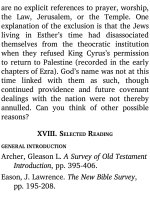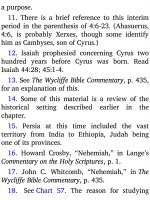Jensens survey of the old testament adam 176
Bạn đang xem bản rút gọn của tài liệu. Xem và tải ngay bản đầy đủ của tài liệu tại đây (118.16 KB, 4 trang )
between “under the sun” and “vanity.” The
phrase “under the sun” refers to the
earthbound,
temporal
outlook
and
experience of the natural man, and this is
vanity, or futility. So, in Ecclesiastes the
phrases “under the sun” and “vanity” refer
to the same thought. The opposite outlook,
the hopeful one, is that which looks toward
God, who is above the sun. With this in
mind, scan your marked Bible, with its
markings of the key phrases noted above.
Observe which sections are about God more
than they are about vanity, and which are
about vanity more than about God. Record
your ndings on paper. Do you observe any
pattern?
4. Compare 1:2 and 12:8. Since these
similar verses appear at the beginning and
end of the book, what do they suggest as a
prominent theme of the chapters in
between?
5. Read 1:1-11. How does the section
serve as an introduction to the book?
6. Read 12:9-14. How do these verses
conclude the book?
C. SURVEY CHART
Chart 76 is a survey chart of Ecclesiastes,
showing how the book is organized,
thoughtwise.7 Refer to it as you follow each
of these suggestions:
1. Note how the introduction (1:1-11) is
identi ed. The premise, or proposition, that
“all is futility” (1:2, margin) is restated in
the conclusion, at 12:8.
2. The main body of the book is 1:12—
12:7. Observe on the chart that this is
divided into four sermons. These sermons of
the Preacher could also be called discourses
of the Teacher. Each sermon expounds on
two subjects: (1) futility (vanity); and (2)
hope. In other words, in each sermon
Solomon rst shows the hopelessness of life
where the outlook is earthbound (“under the
sun”); and then he shows that real hope is
founded only on God, whose dwelling place
is beyond the heavens.
3. Observe what is recorded in the oblique
spaces on Chart 76. The rst part of each
sermon is mainly observation, where the
preacher tells what he, as a natural man,
saw. Hence, the repeated phrase in these
sections, “I saw” (e.g., 4:7). The second part
of each sermon also includes observation,
but it is mainly instruction and counsel about
things of God.
4. Note how the conclusion (12:8-14) is a
condensed summary of the four sermons:
Part One: Observation; “All is vanity” (12:8).
Part Two: Instruction and Counsel: “Fear
God” (12:9-14).
5. Groups of proverbs appear at a few
places in the book. chapter 10 is an example.
Note how this is identified on Chart 76.
IV. PROMINENT SUBJECTS
A. TWO LIFE VIEWS
Throughout the book of Ecclesiastes the
author shows two opposite life views. First,
he views things around him as the natural
man would do, without the light of divine
revelation. His conclusion is “All is vanity.”
(Read 1 Cor 2:14.) (He went through this
searching experience himself some time
earlier in his career; read 1:13-14.) But then
the author writes as one to whom God has
revealed Himself, and now his observations
and conclusions have the ring of surety and
hope. For example: “Everything God does
will remain forever” (3:14). This pattern of
alternating
perspectives
continues
throughout the book, as was observed in the
survey study.









